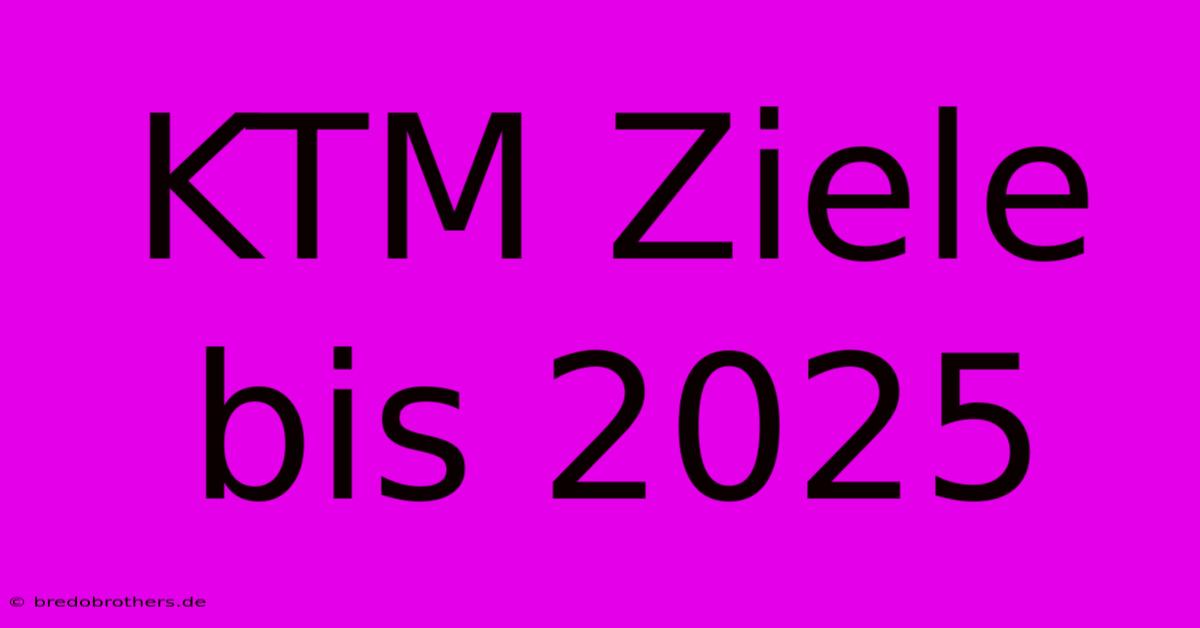KTM Ziele Bis 2025

Discover more detailed and exciting information on our website. Click the link below to start your adventure: Visit Best Website KTM Ziele Bis 2025. Don't miss out!
Table of Contents
KTM Ziele bis 2025: Mein Weg zur E-Mobilität und was ich dabei gelernt habe
Hey Leute! KTM, right? Those awesome motorcycles? Well, I've been following their progress towards their 2025 goals, especially their push into e-mobility, and lemme tell ya, it's been a wild ride – both for them and for my understanding of the industry!
I'll be honest, I was initially skeptical. I'm a total petrolhead – always have been. The smell of two-stroke, the roar of a big V-twin… that's my happy place. So, when KTM started talking seriously about electric bikes, I kinda scoffed. "Electric motorcycles? They'll never be real motorcycles!" I thought. Boy, was I wrong.
Die Elektrifizierung: Mehr als nur ein Trend
KTM's goals for 2025 aren't just about selling a few electric bikes to appease the green crowd. They're talking serious market share, a complete shift in their product line. They're aiming for a significant portion of their sales to come from electric models by 2025. That's a huge commitment. And it's not just about the environment – it's about adapting to changing regulations and consumer preferences. Governments worldwide are pushing for cleaner transportation, and if KTM wants to stay relevant, they gotta play the game.
My own journey of understanding this shift started with a lot of research. I mean, serious research. I read articles, watched countless YouTube videos (some really good, some… not so much), and even went to a few electric motorcycle events. It was overwhelming at first – all the technical jargon, the different battery technologies… my head was spinning. But slowly, things started to click.
Herausforderungen und Chancen
One of the biggest challenges for KTM, and for the entire electric motorcycle industry, is battery technology. Range anxiety is real. People don't want to be stranded with a dead battery miles from anywhere. And battery life, charging times, and cost are all huge factors. KTM is obviously aware of this; they're investing heavily in R&D to improve battery technology and charging infrastructure.
But the opportunities are equally massive. Electric motorcycles offer instant torque, near-silent operation (which I found surprisingly appealing!), and lower running costs. They're also far less polluting than gas-powered bikes. KTM's strategy seems to be focused on combining the excitement of their traditional bikes with the advantages of electric power. This includes focusing on lightweight designs and powerful motors to achieve thrilling performance characteristics.
Meine eigenen Learnings
My initial skepticism has completely vanished. I've learned that e-mobility isn't just about saving the planet; it's about innovation and the future of transportation. KTM's commitment to achieving their 2025 goals shows they understand this. They are cleverly integrating electric technology into their brand identity and addressing the issues of range, charging, and performance.
Key Takeaways:
- KTM's 2025 goals are ambitious but achievable: They're not just talking; they're investing heavily in R&D and infrastructure.
- Electric motorcycles are rapidly improving: Battery technology is advancing, and range anxiety is becoming less of a concern.
- The future of motorcycling is electric (at least partly): KTM's moves indicate a wider trend within the industry.
I'm genuinely excited to see what KTM releases in the coming years. Their progress toward their 2025 goals will be fascinating to watch. I've gone from a doubter to a cautiously optimistic enthusiast – and that's saying something! So, keep your eyes peeled – and your ears open for the quieter hum of the future. It's coming.

Thank you for visiting our website wich cover about KTM Ziele Bis 2025. We hope the information provided has been useful to you. Feel free to contact us if you have any questions or need further assistance. See you next time and dont miss to bookmark.
Featured Posts
-
Psg Ueberrollt Bayern Sangare Trifft
Nov 27, 2024
-
Bayern Siegt Dank Kims Kopfball
Nov 27, 2024
-
De Ketelaere Zwei Tore Drei Vorlagen
Nov 27, 2024
-
Leverkusen 5 0 Sieg Dank Wirtz
Nov 27, 2024
-
Krise Bei Leipzig Nach Mailand Niederlage
Nov 27, 2024
